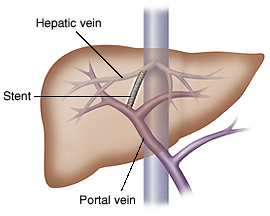TIPS (Transjugular Intrahepatic Portosystemic Shunt)

A healthy liver does many important jobs. It processes alcohol, food, and medicines. It makes digestive juices, helps with blood clotting, and helps your body fight infection. The portal vein is the large vessel that carries most of the blood from the intestine to the liver. Certain diseases or a blockage in the portal vein can cause blood pressure to rise in this vein. This often leads to fluid buildup in the belly (abdomen) and high pressure in dilated veins which can cause massive bleeding. The TIPS procedure helps ease the pressure in the portal vein. It also eases pressure in the veins of the stomach, esophagus, and bowel and lowers the risk of bleeding from these veins. The procedure is done by a specially trained doctor called an interventional radiologist.
Although the TIPS procedure can lower portal pressure, it may make liver failure worse in people with severe liver disease. Encephalopathy can happen if too much blood bypasses the liver after a TIPS. Encephalopathy comes from toxins in the bloodstream that are normally filtered by the liver. The toxins build up in the brain. This can cause mental confusion, personality changes, memory loss, and sleepiness. Encephalopathy can be treated by having the stent in the bypass revised or completely blocking it off.
Getting ready for your procedure
Follow any instructions you are given to get ready. This includes any directions you’re given for not eating or drinking before the procedure.
Tell your healthcare provider if:
-
You are pregnant or think you may be pregnant
-
You are breastfeeding
-
You have any medical conditions
-
You are allergic to X-ray dye (contrast medium) or other medicines
Tell your provider about all medicines you take. You may need to stop taking some or all of them before the test. This includes:
-
All prescription medicines
-
Over-the-counter medicines such as aspirin or ibuprofen
-
Illegal drugs
-
Herbs, vitamins, and other supplements
During your procedure
TIPS is a complex procedure. Your healthcare provider will explain it to you. Below is a summary of what will happen during the procedure.
-
You will be under general anesthesia or conscious sedation. You will have an IV (intravenous) line to give you fluid and medicines. You will also be given medicine through the IV to help you relax.
-
Medical staff will inject a local anesthesia to numb the skin at the incision site. The healthcare provider will make a very small cut (incision) on the right side of your neck. The provider will put a needle with a guide wire attached through the incision into a vein.
-
The provider will inject X-ray dye into the vein. This helps the vein show up clearly on X-ray images. Using these images as a guide, the radiologist moves the needle into another large vein in the liver (the hepatic vein).
-
The provider will push the needle through the wall of the hepatic vein into the portal vein. A thin flexible tube (catheter) is threaded over the guide wire. The provider will move a metal mesh cylinder (stent) through the catheter and place it over the needle between the hepatic and portal veins. The stent creates a passageway (shunt) between the 2 veins. Blood flows freely through the shunt into the hepatic vein. This eases the high pressure in the portal vein.
-
When the procedure is finished, the needle, wire, and catheter are taken out. The stent stays in place to hold the shunt open.
After your procedure
-
Your blood pressure and pulse will be watched closely for several hours after the procedure.
-
You will not be able to eat or drink for several hours after the procedure.
-
The catheter in your neck may stay in place for a day or longer.
-
You may have 1 or more ultrasound tests to check how well the shunt is working.
-
You will stay in the facility or hospital overnight for observation.
Possible risks and complications
All procedures have some risk. Possible risks of this procedure include:
-
Pain, bleeding or infection at the injection site
-
Allergic reactions to X-ray dye
-
Liver injury, including internal liver bleeding
-
X-ray radiation exposure
-
Worsening of liver failure
-
Hepatic encephalopathy
-
Blockage of the stent with symptoms returning
Online Medical Reviewer:
Neil Grossman MD
Online Medical Reviewer:
Raymond Turley Jr PA-C
Online Medical Reviewer:
Tara Novick BSN MSN
Date Last Reviewed:
11/1/2022
© 2000-2025 The StayWell Company, LLC. All rights reserved. This information is not intended as a substitute for professional medical care. Always follow your healthcare professional's instructions.